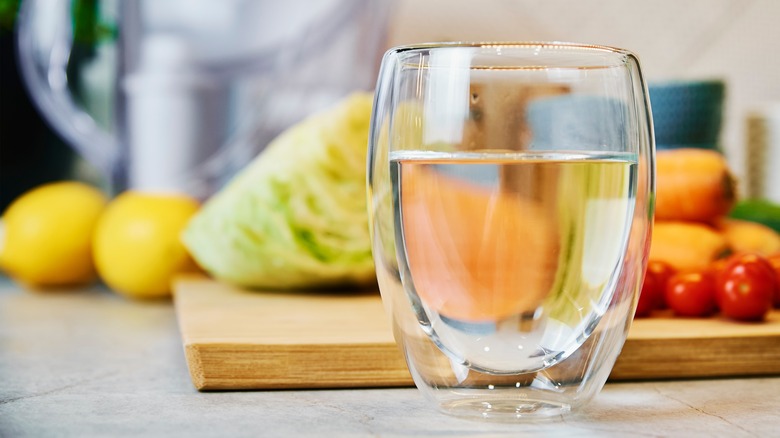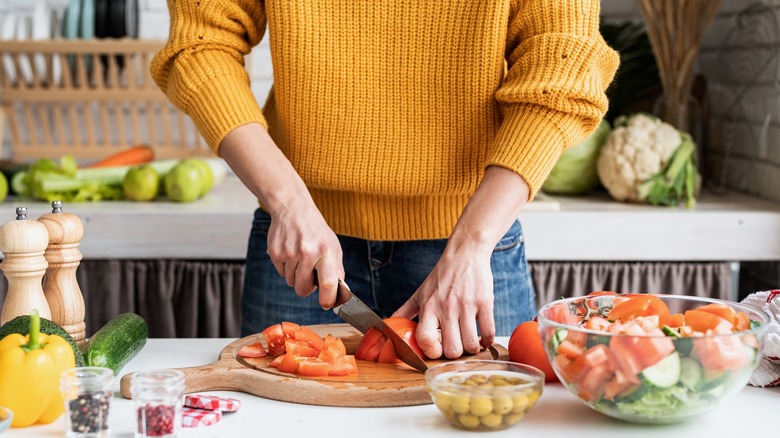This Underrated Fruit Beats Out Watermelon For Most Hydrating
It comes in reds, pinks, and yellows. It's generally a round or oval shape. And it's bursting with tons of juice. What's this super-hydrating fruit? If you said watermelon, guess again. It's none other than the humble yet hearty tomato.
First thing's first: Yes, tomatoes are technically a fruit. Bell peppers, cucumbers, and some forms of corn are fruits, too. But regardless of whether you find your tomatoes in the veggie or fruit aisle, you can't afford to overlook their water-packed nature.
Though you've probably noticed how juicy ripe tomatoes can be, you might not realize how much water they contain. As a 2017 study on the heartiness of tomatoes points out, each tomato is made up of 94% water. The rest of their composition includes sugars, fiber, a touch of protein, and lots of vitamins and minerals. By comparison, watermelons clock in at a water composition of 92% (via the Mayo Clinic). Not bad, but a pinch less than you can expect from a tomato.
In other words, you can quench your thirst with the help of a tomato from your local farmer's market stand — or maybe your patio garden. All you need to do is find creative ways to incorporate tomatoes into more of your meals so you can meet (and maybe exceed) your hydration goals.
Meeting your water needs with help from food
If it seems odd to use tomatoes as a way to keep yourself hydrated, remember that you can eat your water as well as guzzle it. That's why you don't necessarily have to drink several glasses of water daily to stay hydrated. In fact, according to the Mayo Clinic, food account for around one-fifth of a person's average water consumption each day.
This doesn't mean you shouldn't keep drinkable water near you, of course. You should, especially if you want to ward off dehydration. It's easy to get dehydrated, and once you are, you can expect unpleasant side effects like dry mouth, dizziness, headaches, cramping muscles, and stomach distress (via the Cleveland Clinic). That's why it's a good practice to carry a water bottle. Yet it's a wise idea to supplement your water intake by selectively choosing water-rich foods.
What hydrating foods belong in your kitchen in addition to tomatoes? You can get a nice hydration surge from other water-heavy food choices like cucumbers, apples, zucchini, and peaches. The more of these water-filled foods you eat, the more water you'll get from somewhere other than a glass. And that means good things for your body and mind, since hydration is good for your heart, great for your skin, and could even stimulate your brainpower.
Sneaking tomatoes into everyday recipes
Now that you know the water superpower of tomatoes, be on the lookout for ways to incorporate them into your breakfasts, lunches, dinners, and snacks. Just be sure that you're using them in their non-dehydrated form. Sun-dried tomatoes are delicious, but they've lost their water content.
The simplest way to add tomatoes into your diet is to dice and toss them into salads, slice and add them into sandwiches, and cut them up for soups and stews. However, you don't have to limit yourself to those traditional tomato recipes or uses. Every now and then, experiment by sneaking tomatoes into other dishes throughout the day.
For instance, consider making a smoothie with tomatoes and perhaps a couple of other fruits and vegetables. It'll be like a cold tomato soup puree, perfect for a recovery drink after an intense workout. (Think of it as a chilled mocktail version of the classic Bloody Mary!) Or make some sweet tomato jam to spread on toast and crackers instead of fruit-and-pectin jelly. It'll be an interesting alternative for your taste buds, as well as a new dessert.
The next time you're shopping, don't just speed past all those beautiful tomatoes on display. They're much more than just another food. They're your secret (albeit not-so-secret to anyone reading this article) to staying hydrated — no water bottle needed.



